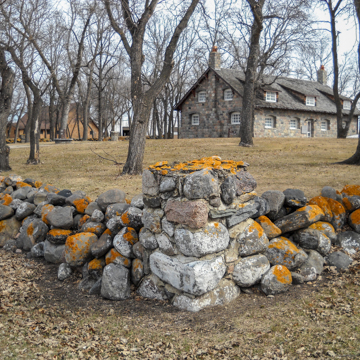The cut-fieldstone Edwards House serves as a retreat for the governor of North Dakota and provides a place to entertain dignitaries. It also functions as quarters for visiting military officials and as a repository for items of a historical nature associated with the state military. Through its history, the building has been known as the Stone Cabin and the Governor’s Cabin. In 1977, it was officially named the Edwards House in honor of Major General Heber L. Edwards, who served as North Dakota’s adjutant general from 1937 until his death in 1962.
Construction began during the fall of 1938 and was completed nearly two years later as a part of a large WPA project at Camp Gilbert C. Grafton (Camp Grafton), which also provided for construction of many needed camp structures such as mess halls, bathhouses, and an infirmary. Approximately 7,000 granite stones, most of which weigh from 80 to 190 pounds, were collected from the nearby shores of Devils Lake and used in the building’s construction. The stonemason in charge of constructing the building was Christ Frosaker, a Norwegian immigrant who farmed and lived north of Sheyenne. Camp Grafton is North Dakota’s principal Army National Guard post.





















